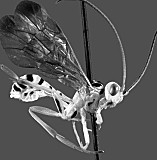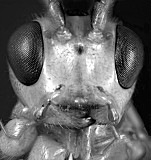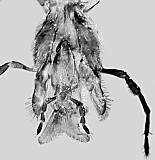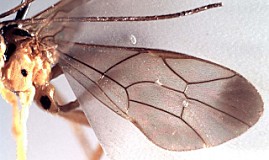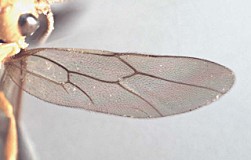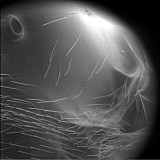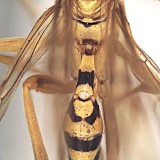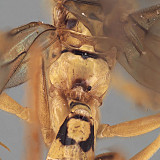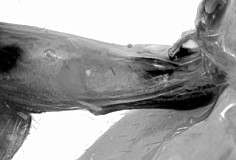Onarion Townes, 1970
Type species: Onarion plaumanni Townes, 1970, by original designation.
Gauld 1997: 181-190 (key to ctenopelmatine genera of Costa Rica; redescription of genus; description of one new species).
Yu and Horstmann 1997: 454 (catalog).
Zhaurova and Wharton 2009: 1-77 (redescription, key, relationships).
In his original description of the genus, Townes (1970) provided few specifics for Onarion, characterizing it almost solely on the basis of color and the reduced occipital carina. Gauld (1997) provided an expanded definition and noted the distinctive additional features of the median apical tooth on the clypeus (Townes 1970 listed this as variable for Onarion) and long malar space (relative to the described species of Physotarsus). The epistomal sulcus is virtually absent, and the two described species have an elongate labiomaxillary complex. On the basis of distribution as well as such features as the widely separated occipital and hypostomal carina and greatly reduced hind wing 1A, Onarion is more closely related to Physotarsus and Catucaba than to Scolobates. It’s placement relative to Physotarsus awaits more detailed study of the latter.
The dorsal margin of the mandible has a distinct basal-median convexity, such that the sharp dorsal margin extending basally from the dorsal tooth is abruptly interrupted at about midlength and depressed over the basal half. The transition is more abrupt than in the few species of Physotarsus and Scolobates that were examined, but this character is not readily visible when the mandibles are closed, and the vast majority of the specimens available have the mandibles closed. In the few other scolobatines where the base is visible, the dorsal ridge of the apical tooth fades to a rounded ridge more gradually as it extends towards the base, and is also displaced medially.
Included species:
O. plaumanni Townes, 1970
O. masneri Gauld, 1997
Head: Clypeal margin blunt laterally, with a slightly protruding, sharply pointed median tooth (Fig. 2). Clypeus about 2.1-2.3 times as broad as long, flat in profile, not distinctly separated from face by a distinct sulcus dorsomedially (Fig. 2). Anterior tentorial pits oval, with lateral corners downturned. Malar space about equal in length to basal width of mandible. Mandible with ventral tooth slightly longer than the dorsal, ventral tooth distinctly separated into an upper, more basal, blunt area and a lower extended apex, sides of mandible almost parallel. Mouthparts haustellate (Fig. 3): glossa, postmentum, galea, and stipes all narrowly elongate. Face 0.9 to 1.1 times as wide as long, smooth, lightly to quite strongly pubescent, with a median tooth or small tubercle dorsally. Inter-antennal area flat to narrowly raised medially, anterior margin of torulus situated at about 0.6-0.7 of eye height. Widest diameter of torulus slightly wider than widest diameter of median ocellus. Area between lateral ocelli flat to slightly depressed, distance between lateral ocelli 0.7-1.1 times their widest diameter, distance from lateral ocellus to eye margin 1.2-1.5 times widest diameter of lateral ocellus. Area behind ocelli sharply declivitous. Antennae with 31-36 flagellomeres, longer than body. First flagellomere with a small tyloid laterally, length of second flagellomere 0.6-0.8 times length of first. Occipital carina present only as an indistinct vestige at mandibular base, never joining hypostomal carina at or before mandibular base. Pronotum dorsally with distinctly impressed transverse groove, anterior margin of pronotum strongly emarginate and exceptionally narrow dorsomedially, abruptly upcurved and broadly rounded laterally. Lateral groove of pronotum extremely vestigial dorsally, absent ventrally. Pronotum usually impunctate. Mesoscutum glabrous, pubescence extremely sparse or absent; notauli absent. Epicnemial carina extending dorsally along ventral 0.3 of pronotum, inclined to, but never reaching anterior margin of mesopleuron. Mesopleuron lightly pubescent, smooth to very lightly punctate. Propodeum (Figs 7, 9) with pleural carinae largely absent, represented by a short vestige posteriorly, lateral longitudinal carinae sometimes present as posterior vestiges; propodeum impunctate, laterally pubescent. Posterolateral edge of propodeum somewhat upcurved. Hind trochanter 2.2-2.5 times as long as basally wide, apical margin of hind trochanter reaching apical margin of trochantellus. Claws fully pectinate (Fig. 6) . Fore wing (Fig. 4) with abscissa of Cu1 between 1m-cu and 2cu-a about 0.7-0.8 times length of 2cu-a. Marginal cell about 3.1 times as long as wide. Hind wing (Fig. 5) with distal abscissa of 1A vestigial, not reaching beyond 0.3 times distance to wing margin. T1 (Figs 8, 9, 10) about 2.2-2.3 as long as posteriorly broad, spiracles slightly protruding in profile. Cerci quite prominent.
Color. Bright yellow with black markings, wings hyaline to yellowish, distal part sometimes brownish-infumate.
Material examined = Argentina, Bolivia, Brazil, Venezuela, and Costa Rica.
There are no specimens currently determined for this OTU, or those specimens determined for this OTU are not yet mappable.
This work owes much to the groundwork provided by Ian Gauld’s study of the Australian and Costa Rican faunas, and we are particularly grateful for his assistance in many aspects of this study. We also thank the following curators and researchers for extended loans of the material used for the revision of Scolobatini and Westwoodiini: David Wahl (AEIC), Ian Gauld and Gavin Broad (BMNH), Andy Bennett (CNC), Gabriel Melo (DZUP), Anders Albrecht and Pekka Malinen (FMNH), Ronald Zúñiga (INBio), and Dave Furth (USNM). Matt Yoder provided considerable assistance along the way, particularly with databasing. Images used here were obtained through the combined efforts of Kira Zhaurova, Heather Cummins, and Patricia Mullins, except for Fig. 8, which was scanned from the original artwork used in the publication by Townes (1970), made available through collaboration with the American Entomological Institute. Our use of PURLs (http://purl.oclc.org) follows the example of their use in publications by Norm Johnson. This content is based upon work conducted at Texas A&M University and supported by the National Science Foundation’s PEET program under Grant No. DEB 0328922 and associated REU supplement nos DEB 0723663 and DEB 0616851.
This material is based upon work supported by the National Science Foundation under Grant Number DEB 0328922 with REU supplements DEB 0723663 and 0616851.
Any opinions, findings, and conclusions or recommendations expressed in this material are those of the author(s) and do not necessarily reflect the views of the National Science Foundation.

